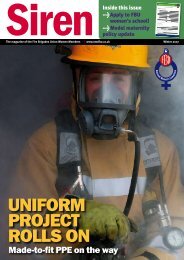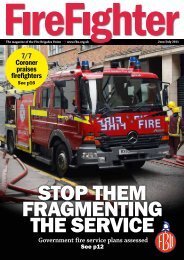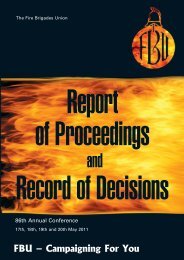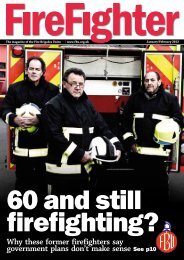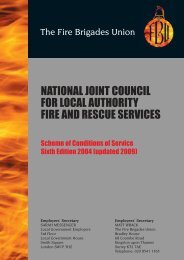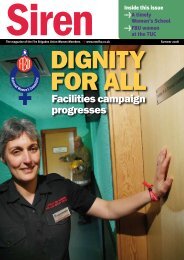Report - Fire Brigades Union
Report - Fire Brigades Union
Report - Fire Brigades Union
You also want an ePaper? Increase the reach of your titles
YUMPU automatically turns print PDFs into web optimized ePapers that Google loves.
SECTION B — FIRE AND RESCUE SERVICE POLICY<br />
which provides written data concerning the incident and<br />
which resources are being mobilised. if there is a fault with<br />
the system this will be done by telephone). If the crews<br />
are not present at the station they will be contacted via the<br />
radio in the appliance. At all times the crews are together<br />
in one place. They differ from wholetime firefighters in the<br />
evening when they are mobilised in the same way as<br />
firefighters working the retained duty system (RDS).<br />
Retained duty system (RDS) firefighters are rarely at the<br />
fire station together (other than, for example, on the<br />
weekly drill night for a few hours). This varies across the<br />
country but is invariably required to be 5-10 minutes or 1-2<br />
miles travel distance. An RDS firefighter (when available for<br />
calls) must be located within a given radius of the fire<br />
station whether at home, work or undertaking other<br />
activities. An RDS firefighter will invariably be at a separate<br />
location when alerted from other members that will form<br />
the appliance crew. They are mobilised by multitone pagers<br />
(alerters). Once paged the RDS firefighter will promptly<br />
attend the fire station and take details of the call there.<br />
RDS firefighters can change their status throughout the<br />
course of the day subject to having provided availability for<br />
an agreed (minimum) total number of hours for the week.<br />
FBU submission<br />
The FBU is informed that the Station End Equipment fitted<br />
into fire stations to mobilise crews will be exactly the same<br />
in a retained station as it is in a wholetime duty (or day<br />
crewed) station. This means that unless crews are actually<br />
on station to hear the turn out system they will not<br />
respond. (This is why RDS firefighters have to have a<br />
separate alert and mobilising arrangements.)<br />
This has led to CLG having to patch up and rethink how<br />
FiReControl will cope with turning out (mobilising) RDS fire<br />
crews.<br />
We are informed by CLG that it is envisaged that changes<br />
to the availability status of RDS crew members will be<br />
done by internet or telephone. This pre-supposes that the<br />
RDS member will have a telephone and/or internet access.<br />
It is very common if not universal that local controls have<br />
one control operator monitoring the availability of RDS<br />
personnel at all times including in those control rooms<br />
where availability is integrated into the system. This matter<br />
has not been considered in the CLG staffing model. We<br />
are informed that CLG are now asking EADS to devise a<br />
solution to retained availability management systems and<br />
that they are writing a programme. This will be similar to<br />
some existing systems used now in controls such as the<br />
Rappel System or Garton systems.<br />
If it is correct that such systems already exist and if both<br />
CLG and EADS had had clear understanding of end user<br />
requirements regarding availability and mobilising of<br />
retained duty system personnel then why did they not<br />
incorporate it into the project initially? What is the<br />
additional cost of this work?<br />
Information provide by the <strong>Fire</strong> <strong>Brigades</strong> <strong>Union</strong> to<br />
CLG Select Committee<br />
24 February 2010<br />
Specific Examples of End User Requirements not being<br />
met by FiReControl<br />
3. Matters arising from the Equality Impact Assessment<br />
Terms and Conditions<br />
The FBU can broadly support the recommendations,<br />
however not without some qualification. These being:<br />
1. The report concludes (page 9)<br />
Even if a gender equality impact assessment had been<br />
undertaken at the earliest possible stage, it is unlikely<br />
that the potential adverse gender impact identified<br />
would have altered the course of the project. CLG would<br />
have needed to balance the requirement to improve<br />
national resilience and enhance the capability of fire<br />
control against the potential equality impacts identified.<br />
The issue of whether FiReControl will/could provide<br />
improved national resilience and enhanced capability aside,<br />
the fact that it is intended that staff will be removed from<br />
their current employer (on transfer) and be placed on<br />
transferred terms and conditions which are vulnerable to<br />
change will mean that these workers – predominantly<br />
women – face the prospect of worsening conditions<br />
including pay. This was made clear to us by an ex-Chair of<br />
the West Midlands LACC who publicised the fact that the<br />
intention of the proponents of the RCC project was to<br />
slash costs by changing pay rates to those in call centres<br />
as soon as is practicably possible – which are<br />
approximately 50% less than current salaries. This could be<br />
avoided if staff were employed by application of the staff<br />
retention model commonly used in the NHS.<br />
2. The report encourages changes to shift patterns. The<br />
current shift patterns which should transfer are widely<br />
regarded by staff as being satisfactory.<br />
RCC Building Design Specification<br />
In December 2009 CLG published an Equality Impact<br />
Assessment (EIA) for the project. In relation to the<br />
buildings this highlighted for example: EIA – para 3.7.2<br />
Concludes that an Access Defect Rectification Plan is<br />
implemented by CLG. This is in response to the realisation<br />
that eight out of nine RCC buildings do not conform to the<br />
DDA in relation to access, door switches/swipes and<br />
hearing induction loops etc. CLG were given a blank piece<br />
of paper at design stage and the department’s persistent<br />
failures in managing the project included a failure to<br />
oversee these points in the first eight buildings blaming<br />
contractors for interpreting the act wrongly! Only London<br />
RCC escaped as it had not yet been completed.<br />
Recommendations<br />
3.7.1. That immediate steps are taken to ensure the<br />
required access standards are met first time in the<br />
construction of the London Regional Control Centre.<br />
74 FBU Annual <strong>Report</strong> 2011





